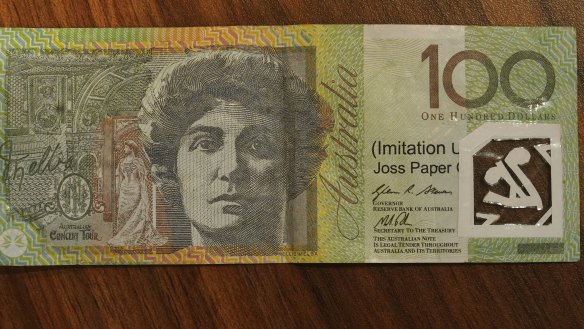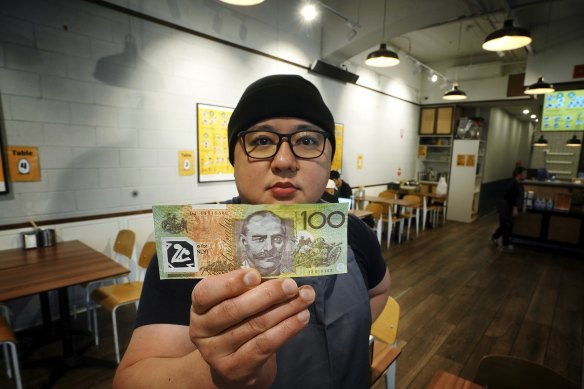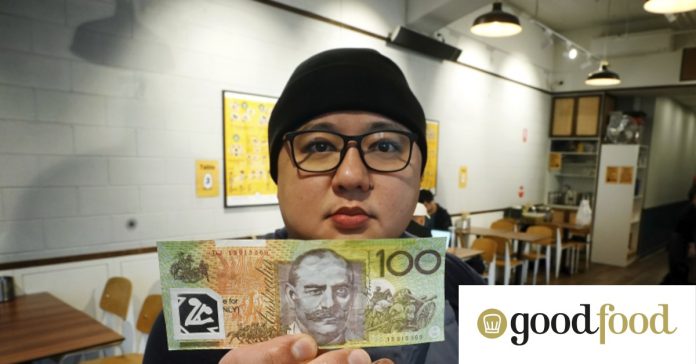[ad_1]
With their credit cards maxed out, more diners are using cash, but alarmingly some of it is high-quality fake in another blow to the struggling hospitality industry.

Melbourne hospitality businesses are already doing it tough, with diners spending less and costs soaring. Now restaurateurs also have to worry about counterfeit currency. Twice in the past month, Omar El Deek from South Yarra’s Cosi has discovered that customers paid for their meals with fake $50 and $100 notes.
It’s never happened before. “Both times, my wife counted the money in the office the next morning, and it was clearly fake. You can tell when you look at it properly. The touch is different, the plastic window on the $50 note doesn’t have the coat of arms.”

El Deek thinks customers at his Italian restaurant were unaware they were carrying counterfeits. “I don’t believe they were trying to scam us,” he says. “The notes were in circulation.” After the second occasion, he bought a detector machine for $300 and is now running every note through it. “We take the money off the table, run it through the machine and if it bounces back, we will let the customer know,” he says.
“With the cost-of-living crisis, criminality goes up, we need to be aware of everything in this world and take defensive techniques.” El Deek is resigned to adding ‘counterfeit sleuth’ to his list of capabilities. “You need to be an expert in everything now,” he says. “Not just food, wine, you need to be the accounting manager, marketing manager, everything. It’s only the brave who survive in restaurants these days.”

Cosi is not the only restaurant to find fake money in their till. TWS Gai Wong in North Melbourne had a customer pay for a $3 soft drink with a fake $100 note. “They came in during a very busy time,” says owner Philip Leong, whose restaurant serves Malaysian chicken rice. “They looked at the menu, then came to the counter and said, ‘I’ll just grab a drink’ and paid with the hundred bucks. It was a quick manoeuvre, and they were very chatty with my staff who, without thinking, gave the change.”
As Leong counted the takings at the end of the night, he suspected something wasn’t right. “The texture felt a bit off,” he says. “There you go: we are $97 down. To me, that is quite a lot of money because my food is only $17. It’s like a family and a half who haven’t paid.” With business already down by about 20 per cent, it’s a big hit.
In St Kilda, Nikki Laski at 90-year-old Monarch Cake Shop has seen it all. “I have a collection of counterfeits,” she says. What’s changed is that the fakes are getting better. “Some of them look like something a child made at home off the printer but the ones I’ve taken over the counter recently are better quality and harder to spot,” she says. There are ways, though. “I turn from the customer and walk towards the till and hold the note in my hand and do a little rip in the paper,” she says. “If it rips, it’s a fake.”

Simon Schluter
Unlike Omar El Deek, she believes anyone passing over fake currency is well aware of it. “Someone comes in with a $50 note and buys something small for $2 or $3.” Instantly, she’s on alert and does the tear test. “If it rips, I say to them, ‘Oh my god, someone has given you a fake.’ I never accuse them, and they take it back.”
Laski is seeing more customers paying with cash in the past few months. “People are over-extended, they can’t put it all on the credit card any more,” she says. “They are drawing on their cash reserves, coming in with boxes from the roof, under the bed.” Her staff are all trained to spot fakes. “Things are tough enough these days,” she says. “When you’re stretched as we are, getting a fake note is like taking $50 and throwing it into the rubbish bin. It’s money that you don’t want to lose.”
The Reserve Bank of Australia publishes counterfeiting statistics every six months. The number of fake notes detected has sat between 2855 and 3831 each quarter since March 2022. The quality varies greatly, with some fakes created as ‘hell money’. These are offerings to ancestors, designed to be burnt in some Chinese cultures, and have none of the security features of real currency. Other banknotes are made to be spent, which is a crime with a maximum penalty of 14 years jail. “I handed my notes into the police, and they said they’re the best ones they’ve ever seen,” said El Deek. “They are clearly in circulation.”
What to do if you suspect money is fake
- Handle as little as possible and store safely in an envelope.
- Note details on how it came into your possession.
- Report it to police (keeping counterfeit currency is an offence).
How to tell if money is fake
Refer to the Reserve Bank of Australia’s Counterfeit Detection Guide, which outlines security features for each currency denomination and series. Australian notes are printed on polymer, which returns to shape after being scrunched and cannot be easily torn. Newer notes include clear windows, raised print and shadow images and parts of the banknote fluoresce under ultraviolet light.
From our partners
[ad_2]
Source link


